Discuss about germs - episode-5
Bacterial cell wall and antibiotics
In the previous episode, we discussed the outer covering of bacterial cells, especially the structural properties of interstitial cell screen, external cell membranes and Periplasm. Through cell screen and Periplasm, the bacteria protect the equation of ion with the surrounding environment, as well as transmitting signals between the two cells, and maintaining the entry and sewerage of particular proteins or other atomic atoms. Cell wall is one of the essential components of bacterial cell defense cells, except cell-screen and Periplasm. To preserve and strengthen the specific shape of cells, mitigation of turgor pressure and role of cell wall in bacterial cell defense is essential.
In this phase, we will know about the structure of bacterial cells cell wall. One can remember that we have a special need to know about cell walls of bacterial cells? Apart from the cell wall, the developed eukaryotes have survived the promise! Yes, that's exactly why we need to know better about our cell walls! If I say a little, then the matter will be clear.
Most of our doctors give our antibiotics when we go to a doctor when we have fever, diarrhea or other bacterial infection. Good to know, most of the antibiotics that are present in the bacteria spoil the cell wall of the cell! Once the cell wall is destroyed, it is virtually impossible to tolerate abrasive pressure for one-bacterial bacteria, and the bacteria breaks into cells, and it is called cell lysis in the language of science. Because there is no cell wall in our cells, the effects of antibiotics do not harm our cells.
Scientists have been relentlessly researching the laboratories of the world to create more advanced antibiotics for the treatment of various diseases caused by bacteria and to know more about the functional and structural features of the cell wall of the bacteria.
What is this cell wall? How do bacteria build out the outer shell of the cells? These things are a little better then you know.
The main components of the cell wall of the bacteria are peptidoglycan or murein polymers. Inside the inner membrane of the peptide-glycone polymer composed of sugar and amino acids, form a three-dimensionally strong and consistent array of nets. For the bacterial cells, this peptidoglycan polymerically forms the defense force, like the rope-row brick arranged around our house, in the form of a defense wall or wall. And that's why this lining is called cell-wall.
Peptidoglycan contains two main types of carbohydrates: N-acetylglucosamine (NAG) and N-acetylmuramic disaccharide (NAM).
This N-acetylmuramic disaccharide or NAM is a very interesting sugar molecule because it adds a peptide chain made with 3-5 amino acids. Peptide is associated with carbohydrates in nature, but it is very rare. Another interesting fact is that the presence of D-Amino Acids in this Papataide chain of NAM can often be seen, such as D-Allanin, D-Glutamic Acid and D-Glutamine (L.R. D. Stereoisomer, in Chemistry Class Sure, I did not discuss it in more detail! ). Knowing the good Eukaryote and prokaryotic cells, millions of proteins are composed of different amino acids, but there is never D-amino acids. Only the presence of L-Amino Acids found in all the proteins that have been discovered so far. If you see it, the structural units of Peptidoglycan are unique in nature!

During the formation of peptidoglycan or murien, NAG and NAM produced two polymers continuously in uniform and produced numerous polymers. These polymers alone are not enough to strengthen the bacteria. An ecosystem called Transpeptidase, which is a three-dimensional and coordinated network of these polymers. The peptide chain suspended from various sugar polymers is blocked by the transpeptidase enzyme through the peptide-bond. As a result, polymers made from sugar and amino acids, together with each other, form a very strong three-dimensional cell wall.
Although this whole process of cell wall-making is completed, the interstitial cell-screen and the interstitial space is not formed in periplasm, but the proteins / protec or peptidoglycan structural units are formed in periplasm. They are all made in cell juice or cytoplasm. The cell wall components are transmitted to periplasm through the integral membrane proteins that have intermittent cell membranes.
All the enzymes that help in the formation of the structural unit of the peptideaglycons in the cells, which helps in transferring membrane proteins to their periplasm and proteins / enzymes that are formed in the periplasm with the help of the enzyme, are considered important in antibiotic treatment.
Examples of some common antibiotics that destroy the cell wall of the bacteria

Thanks for this information Sir.
I am resteemating your post.
Thank you very much.
I think you present some really interesting scientific info on your blog, however, would you mind sourcing your information please? I think this is far too technical to not be referenced. I think you'd get more upvotes if you did.
@choogirl Thank for the advice i will try to do this for next time.